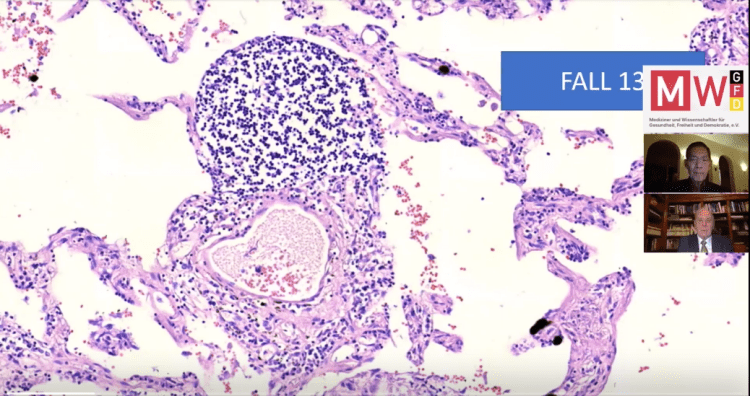The evidence
We herewith present scientific evidence that calls for an immediate stop of the use of gene-based COVID-19 vaccines. We first lay out why the agents cannot protect against viral infection. While no positive effects can be expected, we show that the vaccines can trigger self-destructive processes that lead to debilitating illness and death.
Why the vaccines cannot protect against infection
A fundamental mistake underlying the development of the COVID-19 vaccines was to neglect the functional distinction between the two major categories of antibodies which the body produces in order to protect itself from pathogenic microbes.
The first category (secretory IgA) is produced by immune cells (lymphocytes) which are located directly underneath the mucous membranes that line the respiratory and intestinal tract. The antibodies produced by these lymphocytes are secreted through and to the surface of the mucous membranes. These antibodies are thus on site to meet air-borne viruses, and they may be able to prevent viral binding and infection of the cells.
The second category of antibodies (IgG and circulating IgA) occur in the bloodstream. These antibodies protect the internal organs of the body from infectious agents that try to spread via the bloodstream.
Vaccines that are injected into the muscle – i.e., the interior of the body – will only induce IgG and circulating IgA, not secretory IgA. Such antibodies cannot and will not effectively protect the mucous membranes from infection by SARS-CoV-2. Thus, the currently observed “breakthrough infections” among vaccinated individuals merely confirm the fundamental design flaws of the vaccines. Measurements of antibodies in the blood can never yield any information on the true status of immunity against infection of the respiratory tract.
The inability of vaccine-induced antibodies to prevent coronavirus infections has been reported in recent scientific publications.
The vaccines can trigger self-destruction
A natural infection with SARS-CoV-2 (coronavirus) will in most individuals remain localized to the respiratory tract. In contrast, the vaccines cause cells deep inside our body to express the viral spike protein, which they were never meant to do by nature. Any cell which expresses this foreign antigen will come under attack by the immune system, which will involve both IgG antibodies and cytotoxic T-lymphocytes. This may occur in any organ. We are seeing now that the heart is affected in many young people, leading to myocarditis or even sudden cardiac arrest and death. How and why such tragedies might causally be linked to vaccination has remained a matter of conjecture because scientific evidence has been lacking. This situation has now been rectified.
Histopathologic studies: the patients
Histopathologic analyses have been performed on the organs of 15 persons who died after vaccination. The age, gender, vaccination record, and time of death after injection of each patient are listed in the table on the next page. The following points are of utmost importance:
- Prior to death, only 4 of the 15 patients had been treated in the ICU for more than 2 days. The majority were never hospitalized and died at home (5), on the street (1), at work (1), in the car (1), or in home-care facilities (1). Therefore, in most cases, therapeutic intervention is unlikely to have significantly influenced the post-mortem findings.
- Not a single death was brought into any possible association with the vaccination by the coroner or the public prosecutor; this association was only established by our autopsy findings.
- The initially performed conventional post-mortems also uncovered no obvious hints to a possible role of vaccination, since the macroscopic appearance of the organs was overall unremarkable. In most cases, “rhythmogenic heart failure” was postulated as the cause of death.
But our subsequent histopathological analyses then brought about a complete turnaround. A summary of the fundamental findings follows.
| Case # | Gender | Age (years) | Vaccine (injections) | Time of death after last injection |
| 1 | female | 82 | Moderna (1. and 2.) | 37 days |
| 2 | male | 72 | Pfizer (1.) | 31 days |
| 3 | female | 95 | Moderna (1. and 2.) | 68 days |
| 4 | female | 73 | Pfizer (1.) | unknown |
| 5 | male | 54 | Janssen (1.) | 65 days |
| 6 | female | 55 | Pfizer (1. and 2.) | 11 days |
| 7 | male | 56 | Pfizer (1. and 2.) | 8 days |
| 8 | male | 80 | Pfizer (1. and 2.) | 37 days |
| 9 | female | 89 | Unknown (1. and 2.) | 6 months |
| 10 | female | 81 | Unknown (1. and 2.) | unknown |
| 11 | male | 64 | AstraZeneca (1. and 2.) | 7 days |
| 12 | female | 71 | Pfizer (1. and 2.) | 20 days |
| 13 | male | 28 | AstraZeneca (1.), Pfizer (2.) | 4 weeks |
| 14 | male | 78 | Pfizer (1. and 2.) | 65 days |
| 15 | female | 60 | Pfizer (1.) | 23 days |
Histopathologic studies: findings
Histopathologic findings of a similar nature were detected in organs of 14 of the 15 deceased. Most frequently afflicted were the heart (14 of 15 cases) and the lung (13 of 15 cases). Pathologic alterations were furthermore observed in the liver (2 cases), thyroid gland (Hashimoto’s thyroiditis, 2 cases), salivary glands (Sjögren`s Syndrome; 2 cases) and brain (2 cases).






